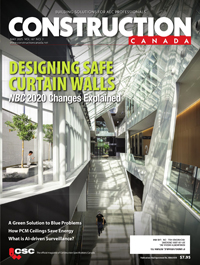The value of transparency documents for construction

Photo © Jeffrey Totaro
Impact categories of an EPD
From the input categories (energy, raw materials, intermediates, and auxiliaries) and output categories (waste, emissions, and co-products’ waste output) of the LCA, impact categories are then quantified within the EPD.
Measure of Impact is a useful area of the EPD to enable a good overview of where the greatest resource usage is happening, as well as the magnitude or size of the impacts. EPDs assess the impact on the atmosphere (e.g. global warming potential, ozone depletion, or smog creation), Earth (e.g. fossil fuel or mineral depletion), and water (e.g. nutrient loading of water or acid rain).
Among the impact categories found in EPDs, typically global warming potential (GWP) and embodied energy (EE) are referenced to understand relative magnitudes of impact among products specified. This is important information for designers to understand so as to design greener buildings—the lower the GWP and EE, the lower the environmental impact of the product. Therefore, these categories are valuable, if not critical, to manufacturers striving to reduce their carbon footprint.
One other important item for comparison is the “functional unit.” This measurement determines how the impact of the product is quantified throughout the EPD. The functional unit measure is based on how the product is typically employed or installed. For example, when one follows this logic, cladding products use m2 or sf (coverage) as opposed to kg or lb (weight). Were an architect to use a weight-based assessment, which has no correlation to how siding is installed, the results would be skewed unfavourably for siding. (Refer to Building for Environmental and Economic Sustainability Technical Manual and User Guide, published by the National Institute of Standards and Technology (NIST) at www.nist.gov/publications/bees-40-building-environmental-and-economic-sustainability-technical-manual-and-user.) As a result, an alternative cladding, possessing a more severe environmental impact, could be selected.
The Leadership in Energy and Environmental Design (LEED) rating system addresses the need for more transparency by requiring EPDs under the current version, LEED v4. This was optional as Pilot Credit 52–Materials Multi-Attribute Assessment under its last edition (LEED 2009). It is worth noting the next iteration of LEED v4, LEED v4.1, is expected to encourage wider use of EPDs.
To qualify for the Materials and Resources (MR) Credit 2, 20 products having “product-specific” EPDs, from at least five different manufacturers, are required to be installed in the constructed building. An “industry-wide generic” EPD is deemed a half-product. Therefore, if only “industry-wide generic” EPDs are provided, 40 products would be needed to qualify for the credit in LEED. In essence, the LEED program recognizes a “product-specific” EPD as a higher standard of environmental stewardship. Therefore, manufacturers are increasingly opting for the more robust cradle-to-grave approach. (Read Dennis Wilson’s article, “Moving in the Right Direction,” published in the November 2017 issue of Walls & Ceilings, for more information.)
The development from start to finish of an EPD by a manufacturer is a serious engagement because it requires devoted human and financial resources over an extended period. The timeline to complete an EPD can range from five to 18 months, depending on the material analyzed or the type of LCA performed. Additionally, an EPD for product A, made in production facility X, is not applicable to the same product produced in facility Y or Z. No two production facilities are exactly alike in how they source materials, manufacture, or deliver products. For this reason, a separate EPD needs to be developed for each product at each facility by the manufacturer to maintain consistency and accuracy.
More than 800 EPDs have been published in North America. Many are for commonly-used products in commercial construction, such as gypsum board, glass-fibre insulation, ceiling tiles, and door hardware. This facilitates the effort needed when incorporating EPDs into a project. Verification is simpler and less time-consuming compared to other credits needed to achieve sustainable design credits. Further, EPDs can be utilized for all methods of construction, be it wood, concrete, or steel. This versatility in offering is one of the reasons EPDs are being prescribed more frequently in project specifications.
From a global perspective, it is worth noting the middle-class is expected to grow to 4.9 billion people by 2030. (Consult Mario Pezzini’s article “An Emerging Middle Class” in the Organisation for Economic Co-operation and Development OECD Observer Yearbook 2012 at oecdobserver.org/news/fullstory.php/aid/3681/An_emerging_middle_class.html.) This segment of the population has the highest level of consumerism, and hence, places the greatest demands on the world’s resources. Therefore, an EPD is a valuable tool for gauging the impact on many of the Earth’s resources, especially non-renewables. Its value extends far beyond the building.







